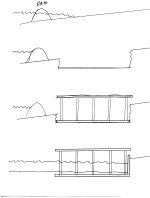inveresk
Platinum Member
Eddie, I share the view of some of the other posters, that a floating boat house might be the answer. Firstly, if the level of the lake rises and falls, then the boat house will follow. The advantage of this is that the relationship of the boathouse to the surface of the water is always the same so should make getting into and out of a boat simpler. if the boathouse is on piers, then the means of accessing a boat from it needs to be variable to take account of rises or falls in the water level - i.e. either a ladder or steps. Not so comfortable for the eldery or infirm. There may be no intention to design for this type of user but it might be a consideration.
I had one project under my direction where we had to demolish an existing jetty, about 100 years old, on the banks of the river Tay. The wooden piles for the pier came out of the silt river bed pretty clean and easy. They were about 15 - 16 inches in diameter, about 30 feet long and even after a century in the river were really solid apart from the outer 1/2" or so which was soft.
The wood was Greenheart, a tropical hardwood, and although I appreciate that calibre of wood isn't available, perhaps at any cost, in this day and age, it does illustrate that timber piers can last if the species of wood is the correct one.
If a floating boathouse or if timber piers aren't an option, then how about steel pile casings sunk into the lake bed then filled with concrete once they're in place? It should be simple enough to design them such that if the steel casings corrode, the concrete is man enough to do the job on its own.
There's a method for filling casings - you have to make sure the concrete pump is sent to the bottom before you start pumping and that you pull it up at the right rate to fully fill the casing. If the mouth of the pump is too high initially, or if you pull it up at too fast a rate while you're pumping, you can get air pockets (which you seriously don't want). I've seen concrete pumps with two meters, a pump volume meter and a rate of withdrawal meter (sounds like a birth control method!) which allows the pump rate to be coordinated with the withdrawal rate to avoid air pockets. We used this method on one job I designed where we had to auger pile through mudstone. We couldn't use driven piles because of the risk of vibration damage to adjacent buildings.
p.s. sounds like a really nice project. Hope the progress photographs will follow in the course of time.
I had one project under my direction where we had to demolish an existing jetty, about 100 years old, on the banks of the river Tay. The wooden piles for the pier came out of the silt river bed pretty clean and easy. They were about 15 - 16 inches in diameter, about 30 feet long and even after a century in the river were really solid apart from the outer 1/2" or so which was soft.
The wood was Greenheart, a tropical hardwood, and although I appreciate that calibre of wood isn't available, perhaps at any cost, in this day and age, it does illustrate that timber piers can last if the species of wood is the correct one.
If a floating boathouse or if timber piers aren't an option, then how about steel pile casings sunk into the lake bed then filled with concrete once they're in place? It should be simple enough to design them such that if the steel casings corrode, the concrete is man enough to do the job on its own.
There's a method for filling casings - you have to make sure the concrete pump is sent to the bottom before you start pumping and that you pull it up at the right rate to fully fill the casing. If the mouth of the pump is too high initially, or if you pull it up at too fast a rate while you're pumping, you can get air pockets (which you seriously don't want). I've seen concrete pumps with two meters, a pump volume meter and a rate of withdrawal meter (sounds like a birth control method!) which allows the pump rate to be coordinated with the withdrawal rate to avoid air pockets. We used this method on one job I designed where we had to auger pile through mudstone. We couldn't use driven piles because of the risk of vibration damage to adjacent buildings.
p.s. sounds like a really nice project. Hope the progress photographs will follow in the course of time.

